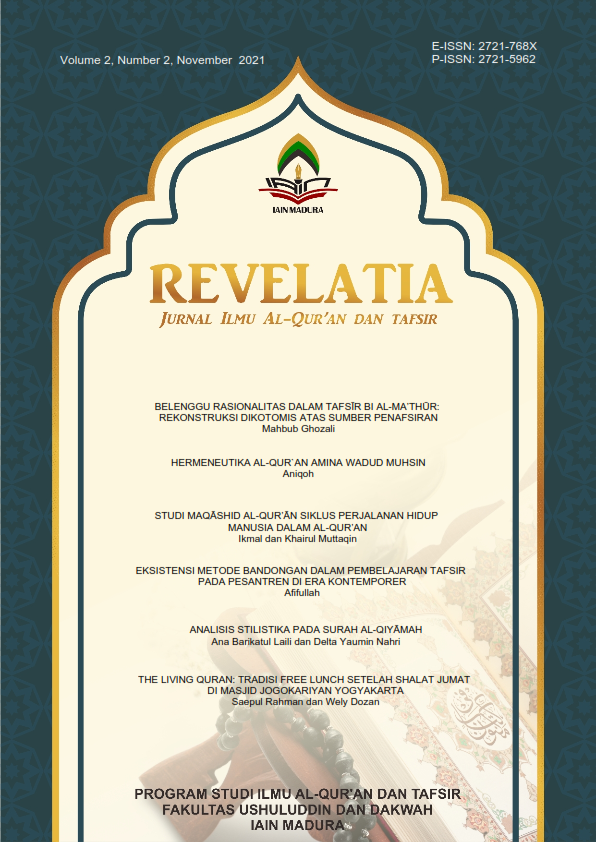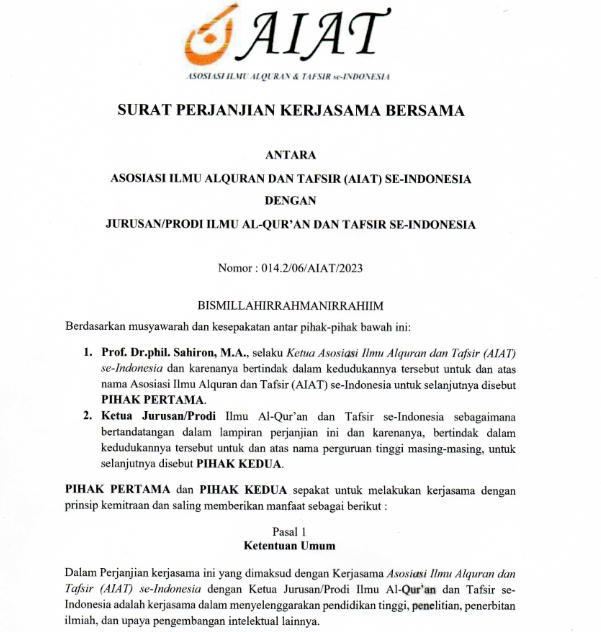ANALISIS STILISTIKA PADA SURAH AL-QIYĀMAH
 Abstract views: 591
,
Abstract views: 591
,
 PDF downloads: 782
PDF downloads: 782
Abstract
The stylistic approach provides a new perspective in the literature studies, especially Qur'anic research. Understanding the Qur'an from a stylistic overview can explain the use of certain words or language structures that distinguish between works. It reveals the characteristics, implied meanings, and beauty of the structure of the Qur'anic text as the primary aspect of the miracles of the Qur'an. The euphemism of the composition of the Qur'an can be seen, for example, in surah al-Qiyāmah. Surah al-Qiyāmah, classified as a makkiyah surah, contains matters relating to the final day, starting from the sacratulmaut stage to the description of the Day of Judgment. Descriptive research with Stylistic analysis in this article, reveals the findings of four aspects of the Stylistics of the Qur'an contained in surah al-Qiyāmah; phonology, morphology, syntax, and imagery. On the phonological aspect, including; fricative, plosive, mukarrarah, and semi-vocal consonants. From the morphological aspect, there are forms of verbs (al-māḍi, al-muḍāri‘ and af‘al al-majhul) which have various meanings. Aspects of syntax contribute to the style of language such as; al-taqdm wa al-ta'khīr, repetition, imperative sentences, and interrogative sentences. Meanwhile, in the imagery aspect, alliteration, assonance, polysindenton, erotic, tautology, ellipsis, synecdoche, and hypalase styles are found.
Downloads
References
Aṣfahānī (Al-), Al-Rāghib. al-Mufradāt fī Garīb al-Qur’ān Beirūt: Dār al-Ma’ārif, t.th.
Asy-Syaukanī. Tafsir Fatḥul Qadir Terj: Sayyid Ibrahim Jakarta: Pustaka Azzam, t.th.
Azwar, Syaifuddin. Metode Penelitian Yogyakarta: Pustaka Pelajar, 1997.
Diakses dari https://kbbi.web.id/harikiamat.html, pada tanggal 25 Maret 2021 pukul 10.34 WIB.
Keraf, Gorys. Diksi dan Gaya Bahasa Jakarta: Gramedia Pustaka Umum, 2006.
Manan, Najihatul Abadiyah. “Studi Stilistika Terhadap Tongkat Nabi Musa as. di dalam Al-Qur’an,” Jurnal Revelatia: Jurnal Ilmu Al-Qur’an dan Tafsir, vol. 1, no. 1 Mei, 2020. Doi: https://doi.org/10.19105/revelatia.v1i1.3169
Mustainna, Ita. “Konfigurasi Kāna wa Akhawātuhā pada Kitab Arbaīn Nawawiyah dalam Konteks Pembelajaran Bahasa Arab.” Al-Af’idah 04. no. 01 Maret. 2020.
Mustaqim, Abdul. Metode Penelitian Al-Qur’an dan Tafsir Yogyakarta: Idea Press, 2015.
Nasution, Ahmad Sayuti. Fonetik dan Fonologi Al-Qur’an, Jakarta: Amzah, 2012.
Qalyubi, Syihabuddin. Stilistika Bahasa dan Sastra Arab Yogyakarta: Idea Press, 2017.
Quthub, Sayyid. Tafsir Fī Ẓilal al-Qurān Juz XXIX Terj: Asad Yasin. Jakarta: Gema Insani, 2004.
Rukmanasari. “Hari Kiamat dalam Perspektif Al-Qur’an: Studi terhadap Surah Al-Qāri’ah.” Skripsi. UIN Alauddin. Makasar. 2013.
Saepudin, Dindin Mohammad. “Penerapan Kaidah La Nahyu pada Juz 30.” Al-Tadabbur 04. no. 01 Mei. 2019.
Sagala, Rumadani. “Pragmatik Istifham.” diakses dari http://ejournal.radenintan.ac.id/index.php/albayan/index
Santosa, Puji. Metodologi Penelitian Sastra Yogyakarta: Azzagrafika, 2015.
Shihab, M. Quraish. Tafsir Al-Misbah Jakarta: Lentera Hati, 2002.
Solḥ (al-), Riyāḍ. al-Munjīd fī Lugat wa A’lāmi Beirūt: Dār el-Machreq Sarl, 2002.
The journal operates an Open Access policy under a Creative Commons Non-Commercial Share-Alike license. All articles published Open Access will be immediately and permanently free for everyone to read and download.
• Creative Commons Attribution-NonCommercial (CC-BY-NC)

Revelatia: Jurnal Ilmu al-Qur`an and Tafsir by http://ejournal.iainmadura.ac.id/index.php/revelatia is licensed under a Creative Commons Attribution-NonCommercial 4.0 International License.
Based on a work at http://ejournal.iainmadura.ac.id.





















